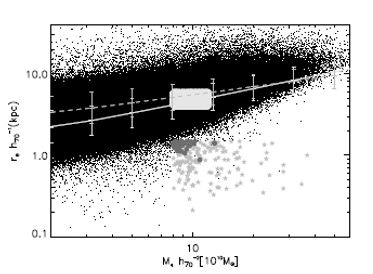















Red nuggets in the local Universe:
relics of the early Universe massive population
Massive galaxies are known to suffer a strong size and morphological evolution, with the ones at high redshift being much more compact than the present-day ones and with more elongated shapes. This opened strong debates about the possible mechanisms for such evolution, some of which predict the presence of massive but still compact galaxies in the nearby Universe. Such galaxies, nick-named 'relics', are thought to be the descendants of the high-z population, remaining like "frozen" over cosmic time.

Stellar mass-size distribution of galaxies from the NYU Value-Added Galaxy Catalog in the SDSS DR6 sample. Compact galaxies are shown with circles. Overplotted are the mean and dispersion of the distribution of the Sersic half-light radius of SDSS early-type (n>2.5; solid line) and late-type (n<2.5; dashed line) galaxies as a function of stellar mass. The gray rectangular area shows the region used to extract the control sample galaxies. (Trujillo et al. 2009)
First attempts:
Only a rather few fraction of galaxies that are both compact and massive have been found in the nearby Universe. In order to find out if these local compact massive galaxies are such relics, we need to study their structural properties and their stellar populations. They should present the same structural properties but just showing an ageing of their stellar populations.
For this means, we fully characterized these nearby objects, obtaining new high-quality spectroscopic data and deep K-band imaging. These objects present disky-like shapes, high radial velocity and velocity dispersion profiles and same density and mass profiles than those at high-z, but they have young stellar populations. Therefore, rather than their relics, this new family of rare objects seems to be their analogs.
See:
Young ages and other intriguing properties of massive compact galaxies in the local Universe; A. Ferré-Mateu, A. Vazdekis, I. Trujillo, P. Sánchez-Blázquez, E. Ricciardelli and I.G. de la Rosa, 2012, MNRAS, 423, 632
Ultra-deep sub-kiloparsec view of nearby massive compact galaxies; I. Trujillo, E.R. Carrasco and A. Ferré-Mateu, 2012, ApJ, 751, 45
New hopes: NGC1277
But, this was not the end of the story, yet... We later obtained deep spectroscopy for a galaxy in the Perseus Cluster, NGC1277. This galaxy caught our attention as it was reported to have an extremely large supermassive black hole on its center, much more massive than one would expect from the known scaling relations between SMBHs and their host galaxy. Promisingly, this object seemed to have the structural parameters required to be a relic (be compact and massive), therefore we needed to study the third criteria: being old along with its entire structure. And... Eureka! from its Star Formation History, we were able to confirm this "frozen" state out to several galactocentric distances, showing that NGC1277 is the first confirmed untouched relic from the early eras of the Universe, even if using a non-universal IMF (see the Universal IMF? section).
See:
NGC 1277: A Massive Compact Relic Galaxy in the Nearby Universe; I. Trujillo, A. Ferré-Mateu, M. Balcells, A. Vazdekis, P. Sánchez-Blázquez, 2014, ApJ, 780, 20
The Initial Mass Function of a massive relic galaxy; I. Martín-Navarro, F. La Barbera, A. Vazdekis, A. Ferré-Mateu, I. Trujillo, M. Beasley, 2015, MNRAS, 541, 108


The neighborhood of NGC1277 as seen by the HST F625W filter. The left panel shows the two closest galaxies whose light contaminate NGC1277. The right panel shows NGC1277 after the subtraction of the contaminant light. The results indicates that NGC1277 is rather symmetric with no distortions neither bright tidal streams surrounding it.
(Trujillo, Ferré-Mateu et al. 2014)
Star formation histories for NGC1277 at different radial distances. This represents the fraction of mass created at each epoch of the Universe. It is clear that the galaxy has not created or accreted more stellar mass since 10 Gyr ago. This is the last evidence that was needed to confirm that this is a frozen relic from the early Universe.
(Trujillo, Ferré-Mateu et al. 2014)
TWO NEW CONFIRMED MASSIVE RELICS
Later, we were able to confirm 2 more compact massive relic galaxies thanks to new data from the Subaru telescope. With these new relics, we found that there seems to be a dependence with the environment: relics in denser environments are more extreme in their properties.
See:
Two new confirmed massive relic galaxies: red nuggets in the present-day Universe; A. Ferré-Mateu, I. Trujillo, I. Martin-Navarro, A.Vazdekis, M. Mezcua, M. Balcells, L. Dominguez, 2017, MNRAS, 467, 1929
We are now working to confirm many more with the cool survey of INSPIRE (PI C. Spiniello)
